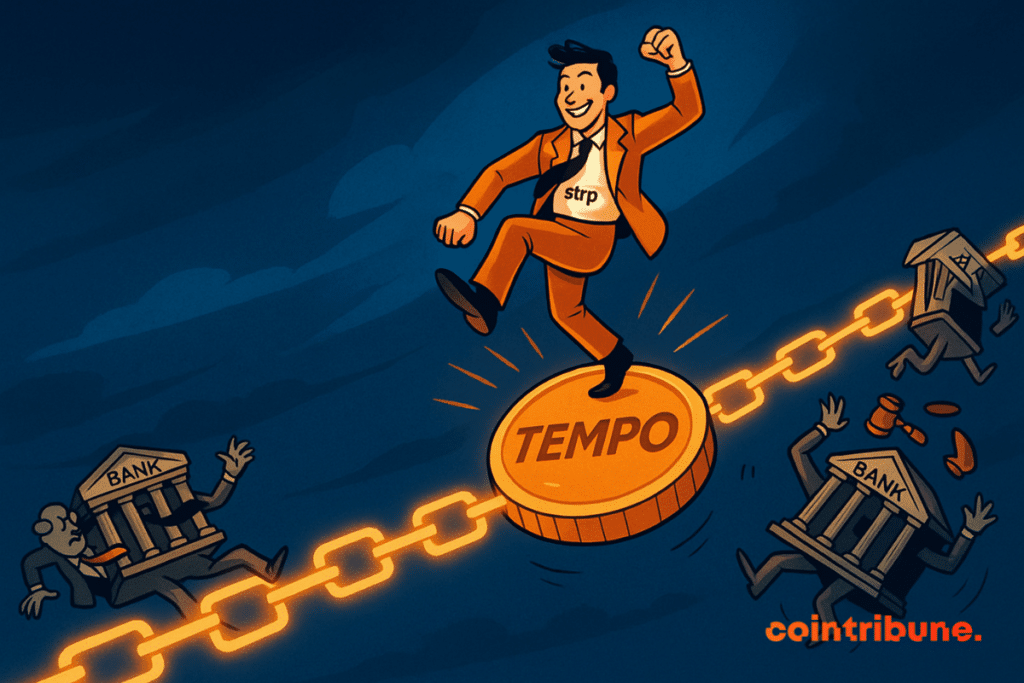Stripe unveils Tempo, a blockchain dedicated to payments in stablecoins
The crypto industry is full of flamboyant players who monopolize attention. But some build in the shadows of the spotlight, patiently, before bursting onto the scene. Stripe belongs to this category. Long present in the world of digital payments, the company is no stranger to betting on disruption. With Tempo, a blockchain designed for stablecoins, Stripe and its partner Paradigm are reshaping the future of global transactions.

In brief
- Stripe launches Tempo with Paradigm, a blockchain designed to optimize stablecoin payments.
- Patrick Collison states that stablecoins finally meet the real needs of global businesses.
- Partners include Visa, Revolut, Deutsche Bank, Nubank, Shopify, OpenAI, and Anthropic.
- The crypto community criticizes Tempo, arguing that an Ethereum Layer 2 would have better served Stripe.
From mistrust to conversion: when Stripe embraces stablecoins
When Solana went after e-commerce, Stripe joined the crypto adventure. A surprise considering that Patrick Collison had long expressed his skepticism. On Hacker News, the CEO of Stripe explained: ” There are many crypto skeptics on HN (and we ourselves have been disappointed by the utility of crypto payments for much of the past decade). So it might be interesting to share what made us change our minds over the past years: we began to notice that many real businesses found utility in stablecoins“.
This shift is not theoretical. Stripe acquired Bridge in 2024, and since then, major clients have launched projects. SpaceX uses it to manage flows in hard-to-reach areas. The Latin American fintech DolarApp relies on it to offer banking services. And an Argentine bike importer pays its suppliers via the Stripe dashboard.
Collison insists:
It is important to emphasize that none of these companies use crypto because it is crypto or for any speculative benefit. They conduct real financial business and have found that crypto (via stablecoins) is simpler, faster, and better than the status quo.
Tempo, the new on-chain SWIFT wanted by Stripe
Stripe and Paradigm don’t want to just participate: they want to build the infrastructure. Tempo is a blockchain designed to operate behind the scenes, like SWIFT or ACH. Collison even described it as a ” decentralized SWIFT at internet scale“. The analogy is not perfect, but it illustrates the ambition.
The technical features are impressive: 100,000 transactions per second, finality in less than a second, EVM compatibility via Reth. Fees are payable directly in stablecoins, with no native token. Tempo also offers optional privacy, a dedicated “payment lane” with memos and access lists.
Stripe has gathered a lineup of partners that lend credibility to the project: Visa, Standard Chartered, Deutsche Bank, Nubank, Revolut, Shopify, OpenAI, and Anthropic.
The vision is clear: enable payments, remittances, tokenized deposits, and microtransactions to go on-chain, without imposing blockchain complexity on end users. For many, this is a serious attempt to transform stablecoins into global payment rails.
Crypto divides: was a new Layer 1 really needed?
The launch of Tempo was not unanimous. Some praise it as an ambitious project, others denounce it as one blockchain too many. Joe Petrich, engineer at Courtyard, reacted bluntly:
No one wants another blockchain. The problems you mention are already solved for those determined to use blockchains, so there is no need for a new chain that claims to “fix” these problems.
Technical criticisms also emerged. Helius Labs stated that Collison was mistaken about Solana’s capabilities, calling his analysis “wrong on several dimensions”.
Others, like Devansh Mehta from the Ethereum Foundation, wonder why Tempo was not built as a Layer 2. According to him, an L2 would have allowed benefiting from the security and interoperability of Ethereum.
Key facts about Tempo
- Launch in September 2025 by Stripe and Paradigm;
- Announced throughput: over 100,000 transactions per second;
- Finality: under one second, no native token, fees in stablecoins;
- Initial partners: Visa, Revolut, Deutsche Bank, Nubank, Shopify, OpenAI, Anthropic.
Stripe defends its choice: its volumes already exceed 10,000 transactions per second at peak activity. For Collison, no current blockchain is calibrated for this scale. Tempo would thus be the necessary tool for the crypto payments world to shift into a new dimension.
Last May, Patrick Collison said that banks are very interested in stablecoins. Four months later, Stripe appears as one of the most committed players in their adoption. With Tempo, the company is not just following the trend: it is trying to shape it, placing stablecoins at the heart of a future global payment system.
Maximize your Cointribune experience with our "Read to Earn" program! For every article you read, earn points and access exclusive rewards. Sign up now and start earning benefits.
La révolution blockchain et crypto est en marche ! Et le jour où les impacts se feront ressentir sur l’économie la plus vulnérable de ce Monde, contre toute espérance, je dirai que j’y étais pour quelque chose
The views, thoughts, and opinions expressed in this article belong solely to the author, and should not be taken as investment advice. Do your own research before taking any investment decisions.